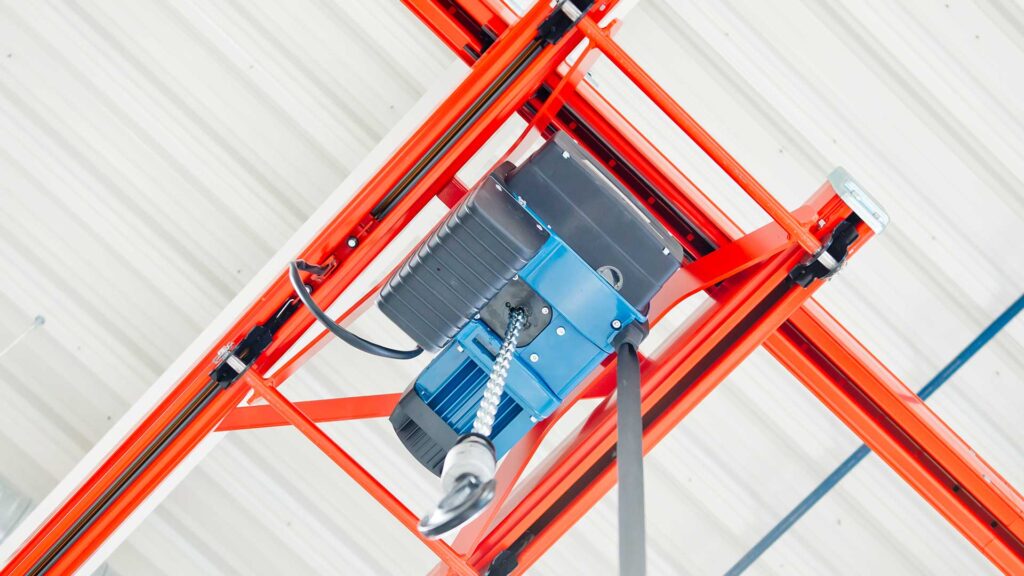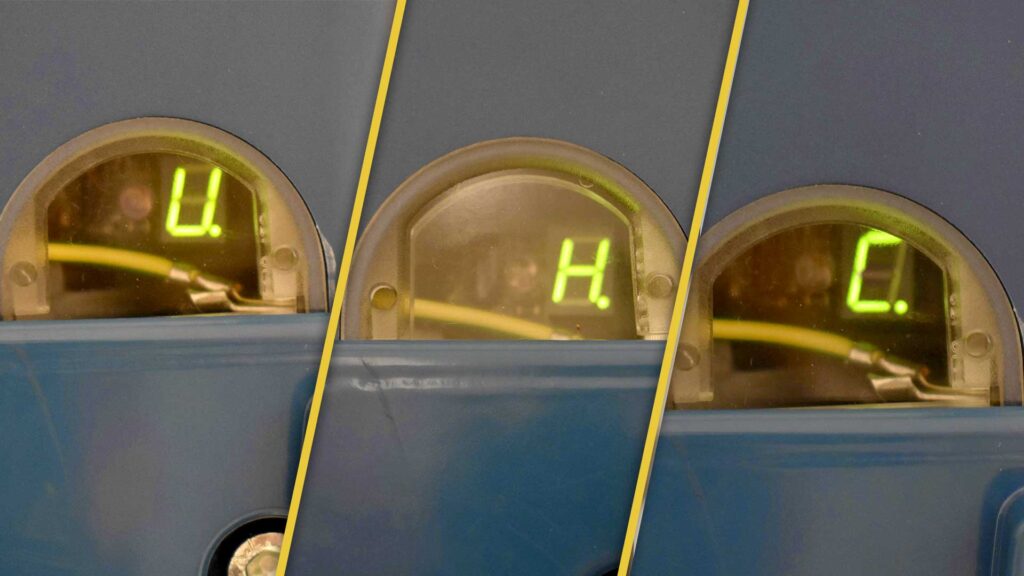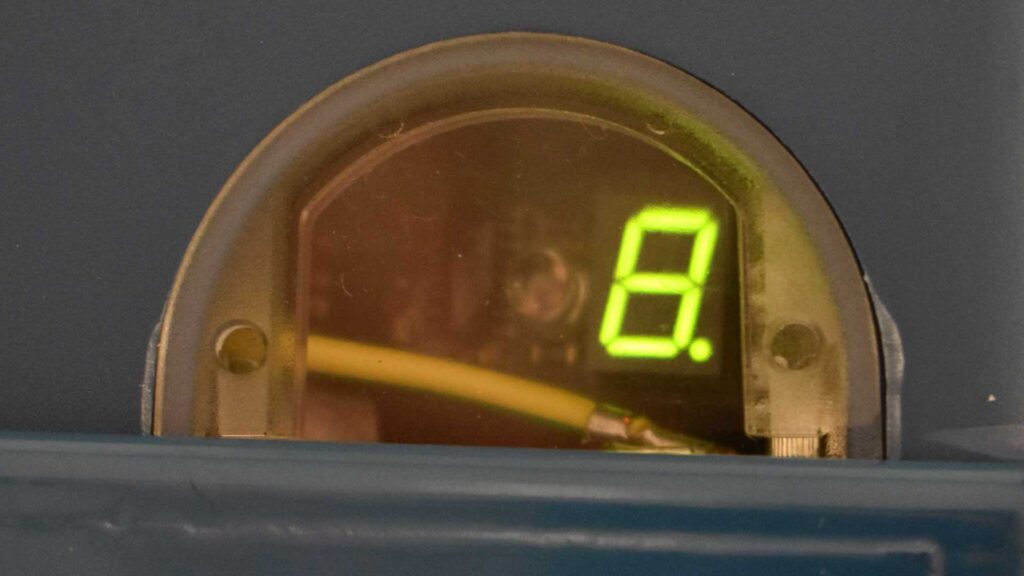Many modern Demag light lifting products have a 7-segment display for operating and error codes. There is a 7-segment display on DC Chain Hoists and the line of electric chain hoist trolleys. Depending on the model you’re working on, these error and warning codes mean different things. To be prepared for your next service call, read on to find out more about the differences in error and waring codes in different Demag products.

Know What Demag Product You’re Working On
Although many Demag products have a 7-segment display, the error and warning codes differ based on the model and type of product. The display may be visible from the ground or you may need to open the service cover to view the display. In the DC chain hoist product line, codes may have different meanings based on whether the model is equipped with two-speed or stepless variable speed. Since Demag electric trolleys used with DC chain hoists are a different product than the hoist, the codes shown in the display have different meanings than the hoist.
Operating Codes – U, H, C
All modern Demag light lifting equipment with a 7-segment display will display operating codes. These codes give you information relevant for inspection and service. DC chain hoists use the operating codes with U, H, and C.

Codes with a U indicate the software level running on the hoist. The U really is a V for version, but the shape is limited by the 7 segment display. The software version is relevant for a service technician who is troubleshooting an issue with a hoist. Codes with an H indicate the operating hours of the hoist. Use the H code for inspections and reset the code when needed. C codes indicate the number of cycles of the contactor. Record the C code during inspections and use it as an indication when contactors should be replaced.
General Operating Codes
All modern Demag DC chain hoists and etrolleys produce general operating codes that indicate normal operating statuses. These codes simply indicate an action is happening. A code that looks like an 8 can mean the emergency stop is actuated. This code can have other meanings when a service technician has been called in to troubleshoot an issue.

Other normal operating codes indicate lifting, lowering, or travel. These codes are shown as segments of the code shaped like an 8. For example on an etrolley, the top two segments of the left corner indicate left/ reverse for E22C trolleys.
Warning Codes
Warning codes appear as a lightning bolt with a numeric value. This code allows movement in the opposite direction and does not require acknowledgement by actuating the emergency stop button. Remember, equipment must not be operated until repaired.

When troubleshooting a DC chain hoist, the warning codes have different causes based on the model. In general, warning codes for two-speed hoists have different causes and meanings than those with stepless variable speed. Stepless variable speed model chain hoists, or DCS models, are normally caused by factors like the incorrect adjustment of the slipping clutch, binding brake, or dirty or defective sensors.
On electric trolleys like the Demag E22C, warning codes have different meanings than in chain hoists. These warning codes may have different meanings based on the travel drive model you’re working with. As a crane service technician, you need to know what model and type of product you are working on to properly troubleshoot and diagnose an issue showing a warning code.
Error Codes
Error codes indicate a malfunction requiring acknowledgement with the emergency stop. These codes are saved in the memory with their frequency and operating hour for additional troubleshooting data. Remember, equipment must not be operated until repaired.

When troubleshooting DC model chain hoists, you may see error codes with an E plus a single number like E1 or an E plus a number like 1.5. Since error codes vary by model, always consult the correct documentation for a listing of error codes and possible causes during the troubleshooting process. The definition of an E3 error code may have different malfunction and cause depending on the DC model chain hoist.
Similarly to chain hoists, Demag electric trolleys also give error codes with an E plus a single number like E1 or an E plus a number like 1.5. Knowing the model type you are troubleshooting is crucial for etrolleys because the error codes will differ based on the model. For instance, an E5 error code will show on both the E22 and E22C but have different causes dependent on the model. Always use the correct documentation when servicing Demag products.
As a crane service technician, troubleshooting is an important part of getting your customer back up and running efficiently. Always consult manufacturers documentation during the troubleshooting process. It’s critical to know correct model being worked on so you can consult the correct documentation.
All modern Demag chain hoists and electric trolleys give normal operating codes for relevant inspection and service intervals. There are codes to show the hoist or etrolley are operating normally, indicating lift or travel. When a warning or error code are shown, these are malfunctions and errors that need addressed by a service technician to be put back into service for the customer.
Do you need assistance with troubleshooting a Demag product? Contact the Demag office nearest you. Find your contact with our Global Contact Locator.
Additional Resources on Light Lifting Equipment
- Demag Provides Light Lifting Equipment for Auto OEMs
- Light Lifting Options for Your Workplace: A Guide to Lifting Light Loads Ergonomically with a Crane
- Jib Cranes: Add Lifting Capabilities Nearly Anywhere in Your Production Facility
- Demag DRC-DC Radio Control System: Efficient Transmitter Replacement - March 26, 2024
- Navigate Model-Specific Codes | Modern Demag Light Lifting Products - November 21, 2023
- Optimizing Demag E22C Travel Drives to Specific Requirements - October 10, 2023
